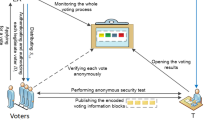Abstract
Electronic voting is an essential tool in modern society. In this paper, we investigate anonymous quantum voting for the travelling ballot. At present, there exist some anonymous quantum travelling ballot protocols, but these protocols are not practical because of the lack of non-reusability or verifiability. Based on Chinese Remainder Theorem, an anonymous quantum voting protocol of the travelling ballot is proposed with an entanglement state, where the partial qubits of the entangled state as the quantum ballot are sent to each voter one-by-one and the other as the corresponding quantum certificate to the tallyman. The proposed protocol can not only ensure non-reusability but also can verify the correctness of the votes.
Graphic Abstract
(1) Define phase operators as voting operators based on Chinese Remainder Theorem; (2) Present an anonymous quantum voting protocol for the travelling ballot; (3) Meet more security requirements, e.g., verifiability, non-reusability and anonymity.




Similar content being viewed by others
Data Availability Statement
This manuscript has no associated data or the data will not be deposited. [Authors’ comment: All data generated or analyzed during this study are included in this published article.].
References
M. Christandl, S. Wehner, Quantum anonymous transmissions. In Proceedings of 11th ASIACRYPT, Lecture Notes in Computer Science, vol. 3788. Springer, Berlin, pp. 217–235 (2005)
M. Hillery, Quantum voting and privacy protection: first steps. Int. Soc. Opt. Eng (2006). https://doi.org/10.1117/2.1200610.0419
J.A. Vaccaro, J. Spring, A. Chefles, Quantum protocols for anonymous voting and surveying. Phys. Rev. A 75, 012333 (2007)
Y. Li, G. Zeng, Quantum anonymous voting systems based on entangled state. Opt. Rev. 15, 219–223 (2008)
M. Bonanome, V. Bužek, M. Hillery, M. Ziman, Toward protocols for quantum-ensured privacy and secure voting. Phys. Rev. A 84, 022331 (2011)
D. Horoshko, S. Kilin, Quantum anonymous voting with anonymity check. Phys. Lett. A 375, 1172–1175 (2009)
Q.J. Xu, S.Y. Zhang, Improvement of the security of quantum protocols for anonymous voting and surveying. Sci. China Phys. Mech. Astron. 53, 2131–2134 (2010)
Y. Li, G. Zeng, Anonymous quantum network voting scheme. Opt. Rev. 19, 121–124 (2012)
L. Jiang, G. He, D. Nie et al., Quantum anonymous voting for continuous variables. Phys. Rev. A 85, 9335–9340 (2012)
Y.W. Wang, Quantum voting protocols based on the non-symmetric quantum channel with controlled quantum operation teleportation. Acta Phys. Sin. 62, 581–586 (2013)
D.S. Sundar, N. Narayan, A novel voting scheme using quantum cryptography (In Proc. Open Systems, 2015). IEEE, pp. 66–71
H.J. Cao, L.Y. Ding, Y.F. Yu et al., An electronic voting scheme achieved by using quantum proxy signature. Int. J. Theor. Phys. 55, 1–8 (2016)
J.H. Tian, J.Z. Zhang, Y.P. Li, A voting protocol based on the controlled quantum operation teleportation. Int. J. Theor. Phys. 55, 2303–2310 (2016)
K. Thapliyal, R.D. Sharma, A. Pathak, Analysis and improvement of Tian-Zhang-Li voting protocol based on controlled quantum teleportation. arXiv:1602.00791 (2016)
K. Thapliyal, R.D. Sharma, A. Pathak, Protocols for quantum binary voting. Int. J. Quantum Inf. 15, 175–179 (2016)
Q. Wang, C. Yu, F. Gao et al., Self-tallying quantum anonymous voting. Phys. Rev. A 94, 022333 (2016)
J.L. Zhang, S.C. Xie, J.Z. Zhang, An elaborate secure quantum voting scheme. Int. J. Theor. Phys. 56, 1–10 (2017)
P. Xue, X. Zhang, A simple quantum voting scheme with multi-qubit entanglement. Sci. Rep. 7, 7586 (2017)
R.H. Shi, Y. Mu, H. Zhong et al., Quantum oblivious set-member decision protocol. Phys. Rev. A 92, 022309 (2015)
R.H. Shi, Y. Mu, H. Zhong et al., Quantum private set intersection cardinality and its application to anonymous authentication. Inf. Sci. 370–371, 147–158 (2016)
Acknowledgements
This work was supported by National Natural Science Foundation of China (No. 61772001 and 61672010).
Author information
Authors and Affiliations
Corresponding authors
Rights and permissions
About this article
Cite this article
Shi, Rh., Qin, Jq., Liu, B. et al. Anonymous quantum voting protocol based on Chinese remainder theorem. Eur. Phys. J. D 75, 20 (2021). https://doi.org/10.1140/epjd/s10053-020-00014-2
Received:
Accepted:
Published:
DOI: https://doi.org/10.1140/epjd/s10053-020-00014-2



